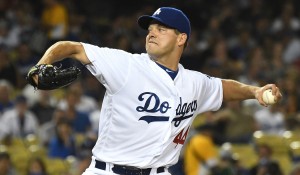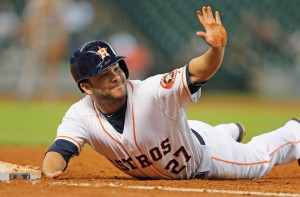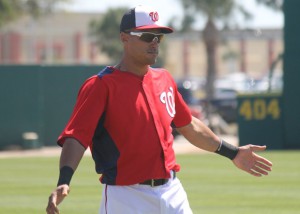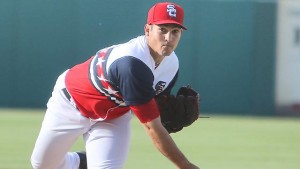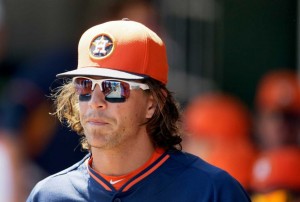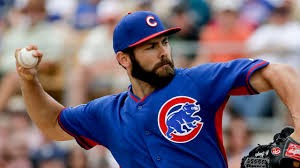It seems like every time I turn around, I see another ex-Nat pitching against us. This past weekend our old friend Tommy Milone surfaced with the Mets to help lead his team to victory against us.
It got me wondering; what’s the best pitching staff of ex-Nats you could come up with right now?
Using a quick and dirty reference guide for depth charts at rotoworld.com, and basically going off of memory of who used to be in our organization, here’s my starting five rotation members, how they were connected with us and how we parted ways.
- Rich Hill, LA Dodgers. He of the near perfect-game turned to walk-off homer loss. Hill was a MLFA signing in March of 2015, threw in 25 games of relief and then was given his release halfway through the season (he probably had an opt-out). From there, he bounced to Boston before signing a one year deal with Oakland where he suddenly was an all-star starter. Oakland flipped him to LA, and now he’s the #2 starter basically on the best team in baseball.
- Robbie Ray, Arizona. He was a big-money draft-pick by us before the new rules came in. Initially seen as a throw-in in the Doug Fister trade, Ray is now the one who “got away.” Detroit moved him to Arizona in the 3-way Didi Gregorius move, and he’s slowly come into his own. He made the All-Star team in 2017 and is one of the better starters in the NL this year.
- Marco Estrada, Toronto. This one still amazes me; we drafted him in 2005 and developed him all the way through his 6-year free agency in the minors, with him showing little of what he now shows for Toronto. After leaving Washington, he signed in Milwaukee and eventually became a solid rotation member for them, but became an all-star in Toronto. I’m tempted btw to also put in Marcus Stroman, who we drafted out of HS as a short stop in 2009 before he went to Duke, learned how to pitch, and became a first rounder.
- Brad Peacock, Houston. He’s got a 11.9 K/9 rate as a starter/swingman for Houston this year. We drafted him under the old “draft and follow” rules in the 41st round in 2006, developed him to the majors, then flipped him in the Gio Gonzalez deal. Oakland then moved him (as they’re apt to do) to Houston in 2013, where he’s pitched ever since. 2017 is easily his best pro season.
- Alex Meyer, Los Angeles Angels. Our second “first round”pick in the 2011 draft (the “Rendon” draft), he was thought to be perhaps too big to start. Initially the trade bounty sent to Minnesota for Denard Span, Meyer took for ever to develop, got flipped to Los Angeles and took til his age 25 year to even debut in the majors. Finally in 2017 he’s showed some promise as a starter (though he’s missed time with a shoulder injury).
Honorable Mentions: Doug Fister, Lucas Giolito, Reynaldo Lopez, Jordan Zimmermann, Nate Karns, Tommy Milone, Nick Pivetta, Mat Latos, Bronson Arroyo, Vance Worley
Interesting. When I started this post I thought it’d be deeper. I struggled to pick the 5th starter over the list of HMs. Would you take any of the honorable mentions over Meyer or Peacock right now? Can you think of anyone I’m missing? Giolito just had a nice start; do you take him over Meyer or these other guys?
Do we have any regrets about any of these guys getting away? Probably not. There’s no way we could have predicted what Hill would have become, and Ray was just a baby when he was flipped. We knew we were giving up talent in Peacock and Meyer … just not knowing how long it would have taken to matriculate. Estrada’s maturation was totally unexpected too.
As far as the honorable mentions go … i’m completely surprised Fister (and Milone for that matter) is still in the league. Giolito/Lopez was giving up talent to get talent. We seem to have dodged a huge bullet with Zimmermann. Karns has never really been healthy enough to show us what he has. Pivetta may eventually come back to haunt us, but his 24-yr old season showed he’s not quite ready for the bigs. Latos and Arroyo are barely hanging on (Arroyo may have already announced his retirement). Worley pitched against us a few weeks ago and beat us but overall his 2017 has been a struggle.
How about relievers? Here’s my best seven ex-Nats relievers out there (feel free to remind me if I forgot someone):
- Felipe Rivero: the big name on this list; he’s exploded onto the scene since being flipped to Pittsburgh in the Mark Melancon deal. He’s got an ERA+ for 2017 of 345, a just ridiculous. He’s my ex-nat closer.
- Blake Treinen: flipped to Oakland in a classic “change of scenery” move and he’s been stellar from day one on the west coast. Sub 2.00 ERA, 7 saves. Will he stay at this level? Hopefully for him, yes.
- Mark Melancon: I know he’s struggled with injury this year, but he’s only 32 and should have plenty of more success. I’ll take him as closer 1-A to Rivero on my Ex-Nat staff.
- Fernando Abad: DFA’d in the 2013 off-season then flipped to our favorite trade partner for a non-prospect minor leaguer, Abad was subsequently stellar for Oakland the following season. He’s been up and down since, but has also been stellar in Boston’s bullpen this year. He’s one of my Ex-Nat Loogies.
- Jerry Blevins: the guy who (I think) Mike Rizzo traded for 50 cents on the dollar because he took the Nats to arbitration in 2015. He got hurt soon after the trade in 2015, but has given the Mets two very solid years out of the pen since.
- Craig Stammen: that’s right; he’s not only back but has had a very nice season in San Diego’s bullpen.
- Yusmeiro Petit: we signed him away from our nemesis San Francisco … and then he struggled badly enough to have his club-option declined. He promptly signed with the Angels and has been quite effective in 2017. He’s my ex-Nat long-man.
Honorable Mentions: Tyler Clippard, Matt Belisle, Michael Brady, Ian Krol, Drew Storen, Josh Smoker, Marc Rzepczynski, Zach Duke, Paolo Espino, Abel de los Santos, Matt Purke, Xavier Cedeno.
So, this is a much better bullpen than starting rotation. Three closer-quality guys at the top and two quality lefties. Both Stammen and Petit have been good this year. There’s a long list of honorable mention Nat relievers at this ponit and there may be others who are sitting in AAA right now.
